Arkansas' Phillips County remembers the racial massacre America forgot
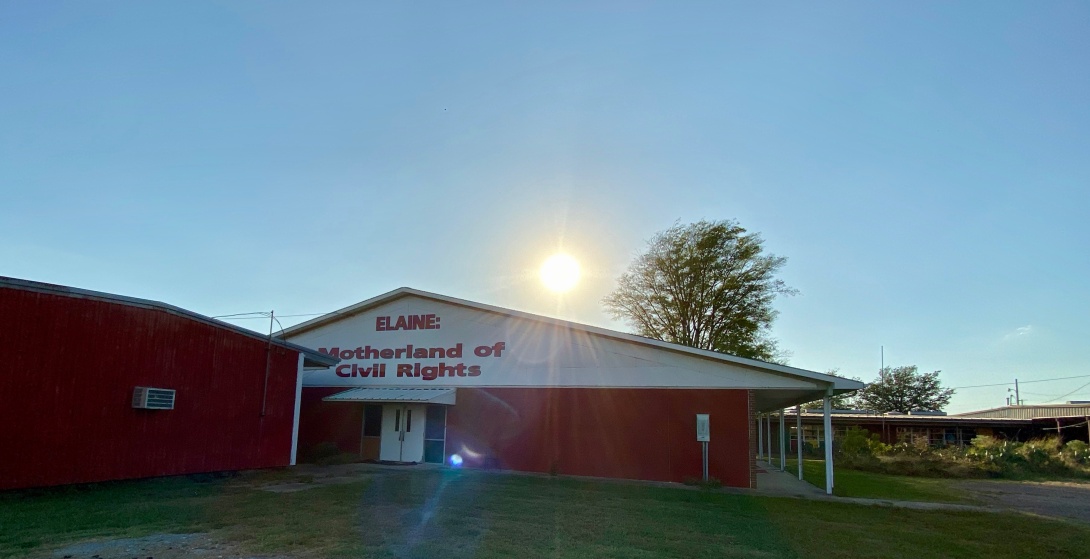
The Elaine Legacy Center in Elaine, Arkansas. (Photo by Olivia Paschal, Facing South.)
"If you are from Phillips County, stand up," Rev. Mary Olson said to the gathering of nearly 100 people, young and old, almost all of them black, at a community center in rural Elaine, Arkansas, on Sept. 28. Nearly everyone stood. "The most important thing is the people of this area are here," she continued. "You are the descendants, whether your people were here or not, of the transgenerational trauma that still exists in this area. You are the important people."
The crowd was gathered to commemorate the 100th anniversary of the Elaine Massacre, perhaps the single deadliest instance of racist violence against African Americans to ever take place in the United States. The murder of hundreds of black farmers, sharecroppers, and businesspeople — men, women, and children — took place in the cotton fields of Elaine and the surrounding rural towns of Phillips County in the Arkansas Delta in late September and early October of 1919. The recent gathering was part of Elaine's eighth annual Healing of the Land ceremony, organized by the Elaine Legacy Center, of which Olson is the president. The event was held not just to remember the massacre's victims, many of whose descendants and relatives were in the crowd, but to continue the work of healing from the ongoing exploitation, poverty, and trauma that still exist here, the legacies of slavery, sharecropping, and the massacre itself.
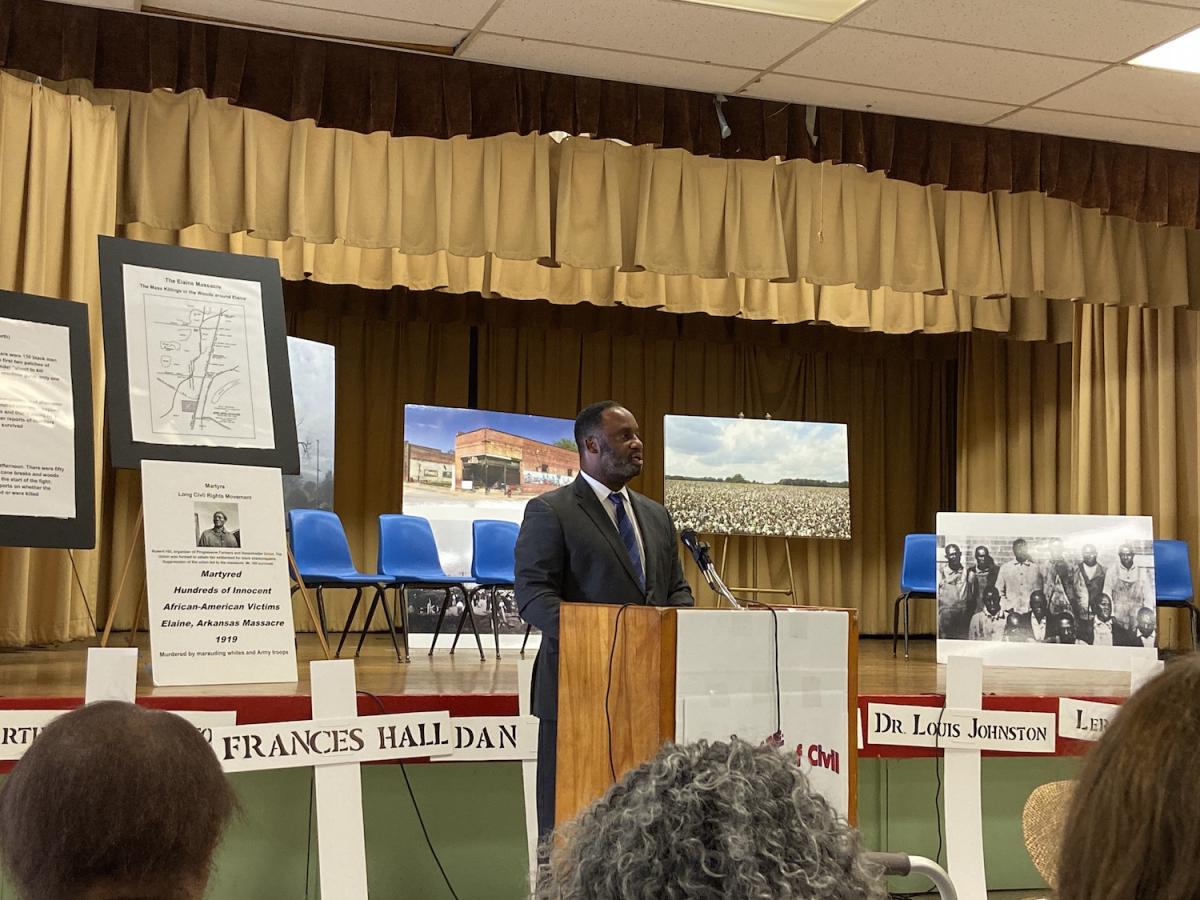
"All of these people back around here, it was their people that happened to," Anthony Davis, whose family has been in Phillips County since before the Civil War, told Facing South, pointing to the crowd gathered for the ceremony. "No new people came here." Davis's brother is one of the few black landowners left in the county, farming soybeans on just over 130 acres that have been passed down through the family to him. But the oral history also handed down through the family recalls a time when they owned vastly more land, he says — land that was stolen by white people.
The past is extraordinarily present in Elaine. It's not only in the stories and the traumas passed down through the generations, but also in the continued segregation and economic inequality on blatant display in Elaine and the surrounding small rural towns. Wealth stratification in the rural parts of the county is almost entirely along racial lines; in Elaine, 65 percent of black people live under the poverty line, compared to just 13 percent of white residents.
With Elaine's population declining, down now to about 500 people, nearly all of the local institutions have shuttered. The schools closed in 2006. Many of the buildings on Main Street now sit empty; a weekends-only convenience store occupies one storefront, and a community center another. The town remains segregated, too, with both Main Street and neighborhoods separated black from white, persistent vestiges of Jim Crow. And though the populations of Elaine and nearby Marvell are 40 percent white, the public school district serving the two towns is 86 percent black, thanks to white parents still sending their children to a private segregation academy in Marvell.
The Elaine Legacy Center serves as a museum, filled with books, artifacts, posters, and oral histories recalling the violence that happened here just two generations ago. In February, it hosted a truth-seeking commission that filled the old school auditorium next door with hundreds of people. But because the local poverty rate is so high, it also functions as a food pantry, clothing closet, and summer camp for local children, who frequent the building and its adjoining community center for a hot meal.
Still mourning the losses
As they were 100 years ago, the fields surrounding the highway from Elaine to Helena-West Helena are planted with cotton. It's puffy and ready to harvest, as it would have been when the white elites whose power was threatened by the unionization of black farmers and sharecroppers convened in the county seat of Helena in 1919.
The city now known as Helena-West Helena, whose population has grown over the past century from around 9,000 to about 11,000, has always been the center of power in Phillips County. Wealthy white planters leased land to black sharecroppers who farmed it for cotton, which they then had to sell back to those same planters for prices far under market value, a form of debt peonage. Constantly shortchanged by the white planters, black sharecroppers and tenant farmers formed the Progressive Farmers and Household Union, which had chapters in the Phillips County towns of Ratio and Hoop Spur as well as Elaine. As the price of cotton skyrocketed from 1915 to 1919 and black landownership rates increased by 40 percent, the union determined it was time to demand fair prices and hired a white lawyer to take the case against the planters to court.
Outraged, Phillips County's white elites gathered in the old Opera House on the Helena square and planned to violently break up the union. Two white men drove to a church in Hoop Spur where they knew a union meeting was taking place. Gunfire was exchanged, and at the end of the night one of the white men was dead. Spreading rumors of a "black insurrection," Helena's white businessmen gathered posses of white men from Arkansas, Mississippi, and Tennessee and waged a three-day war not only on the county's black sharecroppers but on any black person who crossed their path.
White residents and participants later recalled posses chasing black people into the canebrake and shooting indiscriminately at them. The African Americans caught in the violence told their children and grandchildren stories of being placed under house arrest in their own homes, witnessing neighbors gunned down, and being forced by white men to dig mass graves for the victims.
Hundreds of black people were killed: the men and women who had unionized, fleeing children, members of Helena's black business class returning by train from a hunting trip. The names of most of the murdered are unknown and likely unknowable, as are their precise numbers; historians conservatively estimate the dead at 200, while some contemporary counts reach over 800. The killing was done by white mobs, local law enforcement, and, historians believe, the federal troops sent by the governor to quell the violence. Nearly 300 more black people were arrested, imprisoned, and tortured into testifying against each other for the cases brought over the five white people who died in the violence.
No white person was charged with a crime. But the 12 black men to be tried first were all sentenced to death in trials that lasted just minutes. The U.S. Supreme Court eventually overturned six of the Elaine 12's sentences in Moore v. Dempsey, a precedent-setting 1923 decision which established that the 14th Amendment's due process clause could be used to appeal state rulings to federal court to determine whether defendants' constitutional rights had been violated.
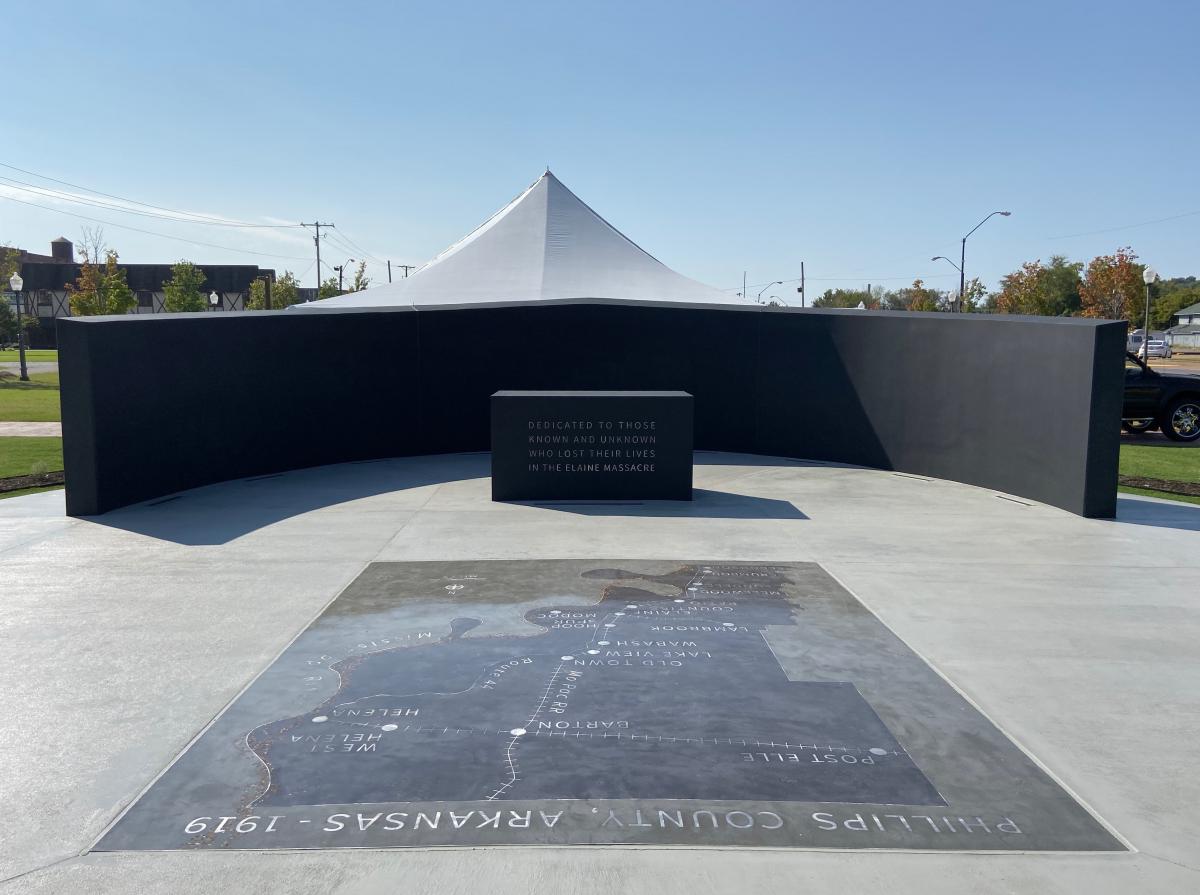
The Elaine Massacre is one of the most important yet least remembered incidents of mass racial violence against African Americans in U.S. history. It has had national reverberations, as the Supreme Court precedent in the Moore case expanded the Supreme Court's ability to intervene in state criminal decisions. In addition, some members of the Progressive Farmers and Household Union later found a place in the Southern Tenant Farmers Union, the first interracial agricultural laborers union in the country, which was organized not far from Elaine in Tyronza, Arkansas, in 1934.
In Elaine today, people are still mourning the loss of life, property, and self-determination stemming from the massacre. They have grown up around physical reminders of the terrorism waged on their ancestors. And the county's current economic situation is in many ways just as dire as it was 100 years ago.
After the massacre, countless black families fled Phillips County. Brian Mitchell, a historian at the University of Arkansas Little Rock who has uncovered new details about the massacre, has traced many of them to Topeka, Kansas, where union organizer Robert Lee Hill also fled. "Two hundred people followed [Hill] with just the shirt on their back," Mitchell told Facing South. Many people in Phillips County feel that both those who left and those who stayed are owed reparations.
"Bring the people back and give them the land back," Davis said. "Put them back on the land and let them feed the world like God intended."
'You could hear every scream'
On Saturday, Sept. 28, the Legacy Center began its weekend of centennial commemorations with a tour of sites related to the massacre. They included the former location of the black church down the road in what then was the town of Hoop Spur, where white mobs gunned down union members and then burned the building to the ground, as well as two mass graves for victims, one in Elaine between the old railroad and the highway, and one a mound rising up out of a cotton field in the nearby town of Lakeview.
William Quiney III, who has lived in Elaine his entire life, stopped at the site of the mass grave in the Elaine city limits. Over there, he explained, pointing across the grassy field, is where his grandfather, Papa Pink, was put under house arrest. Here, he said, gesturing to a flat piece of grass-covered earth in front of him, is where Papa Pink was forced to carry the bodies of his murdered friends and neighbors, one by one, into the unmarked grave.
"If you could just hear him tell about it, you could hear every shot, you could hear every scream," Quiney said. "You could hear, you could feel the pain that people went through that day."
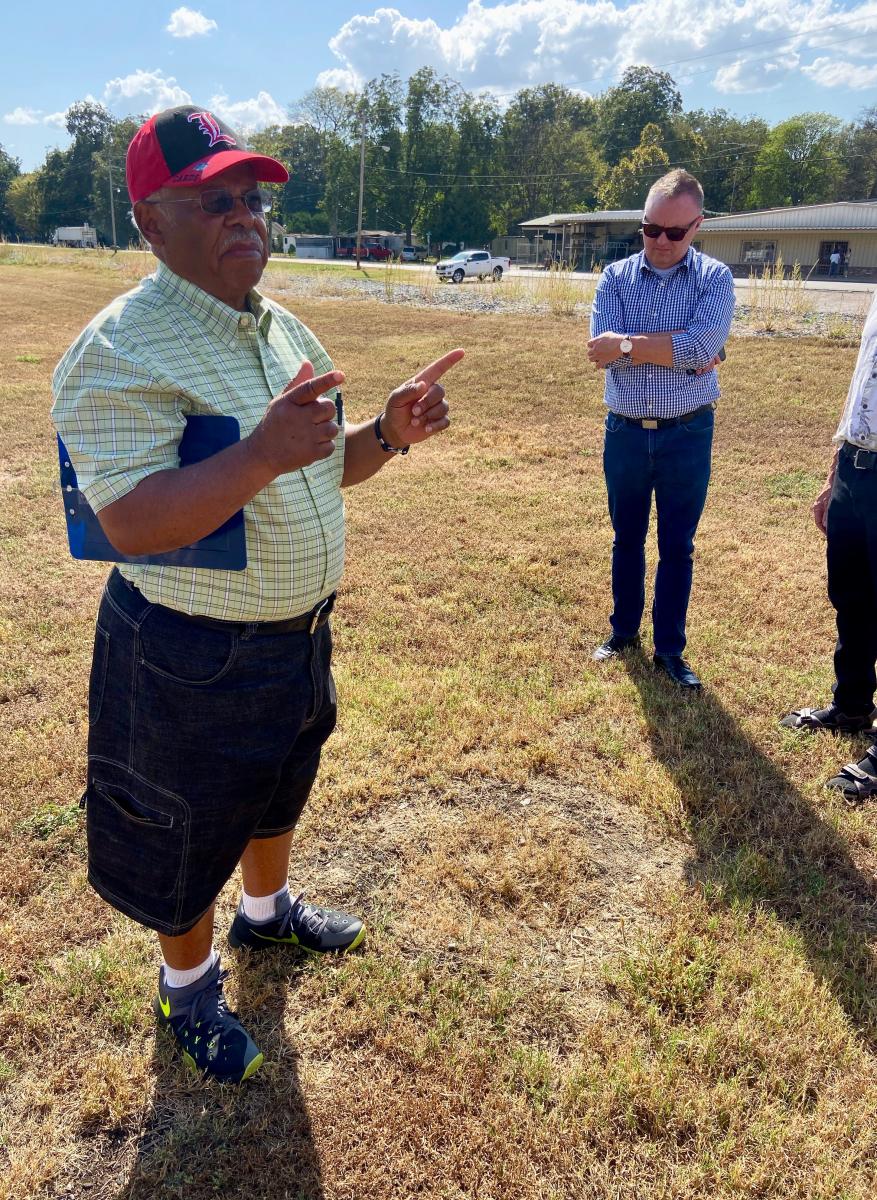
There used to be a willow tree shading the grave, he said, but it had been struck by lightning several years before. Earlier this year, the Legacy Center planted another willow near the site. Just a few months later, it was chopped down and dragged across the field in what those who planted it believe was a hate crime.
The deep racial and economic divides in rural towns throughout Phillips County are part of the reason that many Elaine residents were upset when a group based in Helena announced its intentions to build a memorial to the massacre in that city's square, across the street from the courthouse. The leaders of the Helena committee included U.S. District Court Judge Brian Miller, whose four great-uncles, part of Helena's then-booming black middle class, were killed during the massacre as they returned from a hunting trip, and David Solomon, the descendant of a prominent white Helena family.
Helena also has a claim to the history of the massacre: It was there that white posses formed, and it was in the same county courthouse still in use today that hundreds of black people were jailed without cause, and where the Elaine 12 were subjected to sham trials and sentenced to death.
But the divides that existed between Helena and Elaine in 1919 linger today. For those in Elaine and surrounding rural communities, building an expensive monument in Helena that will draw tourism dollars brings up old resentments and tensions. In remarks at the dedication ceremony for the Helena monument, which took place the same weekend as the Elaine Legacy Center's commemoration, Miller acknowledged the divisions.
"The 30 miles that separated this block and Walnut Street [where black businesses were located] from Hoop Spur might as well have been a million miles," Miller said. "Because there was nothing holding together the black business class, and the sharecroppers meeting in Hoop Spur that night, except for shared history and black skin."
"We return to this block with an earnest yearning for redemption. We return to the spot with an earnest yearning for reconciliation," he continued. "Those of us who failed to take up the cause of the sharecropper seek redemption for failing to help those less fortunate than ourselves. And those of us who joined the mob, or contributed to the slaughter of the sharecroppers, seek redemption for doing the unthinkable."
At a Sept. 29 church service hosted by the Elaine Legacy Center and area churches, Circuit Judge Wendell Griffen, who is also a Baptist pastor, delivered a litany and a sermon in commemoration of the massacre. He has been an outspoken advocate against the memorial's location in Helena, telling Facing South that it is yet another example of the city profiting off of the rest of Phillips County's trauma without a concerted attempt to help those who are still suffering.
"What about the unhealed trauma? What about the uncompensated theft? What about the unreturned proceeds?" Griffen said. "The survivors, the victims, if they have to live with the truth about it, we ought to be honest enough to share that truth and help them bear it, but not only help them bear it, help them repair. Help them heal, help them get restitution."
'Have mercy upon us'
Besides commemorating the Elaine Massacre, people and communities are taking steps towards healing its still-painful wounds.
Sheila Walker, a descendant of massacre victims, and J. Chester Johnson, a white poet whose grandfather participated in the massacre, gathered at Turning Point Park in downtown Elaine for a reconciliation ceremony on Sept. 28. The two met six years ago as Johnson sought to learn more about the massacre, and since then they have engaged in a process of reflection and reconciliation. He is hopeful that the Helena monument will allow others to do the same.
"It's easy for words to evanesce, you know, they disappear," he told Facing South. "One of the advantages of a structure is that it reminds people every day of an event. And that's what I'm hoping — that it will remind people of the need to reconcile." Miller, the district judge, told Facing South that he doesn't see the memorial as an end, but the beginning to a larger conversation. There are efforts underway, he said, to get one of the Equal Justice Initiative's lynching memorials in Elaine. He hopes that one day the memorial will be part of a broader set of exhibits and remembrances of the massacre, stretching from Helena's Delta Cultural Center museum 25 miles southwest to Elaine.
The reconciliation process is not just for Phillips County's older residents. It's also for children from Phillips County and beyond, whose parents, teachers, and mentors brought them to the commemoration events from as far away as Texas to understand a chapter of U.S. history that none of them studied in school.
LaTonia and Robert Gipson, a couple from nearby Sherwood, Arkansas, have made a practice of taking their two children on weekend trips to sites of historical significance in the fight for civil rights. They traveled to Phillips County for the centennial commemoration, eager to hear the oral historians of Elaine and attend the memorial dedication in Helena. Though they both grew up in Arkansas, neither of the Gipsons knew about the Elaine Massacre until they were adults, and they don't want that to happen to their children. Said LaTonia, "This is stuff they'd never learn in school."
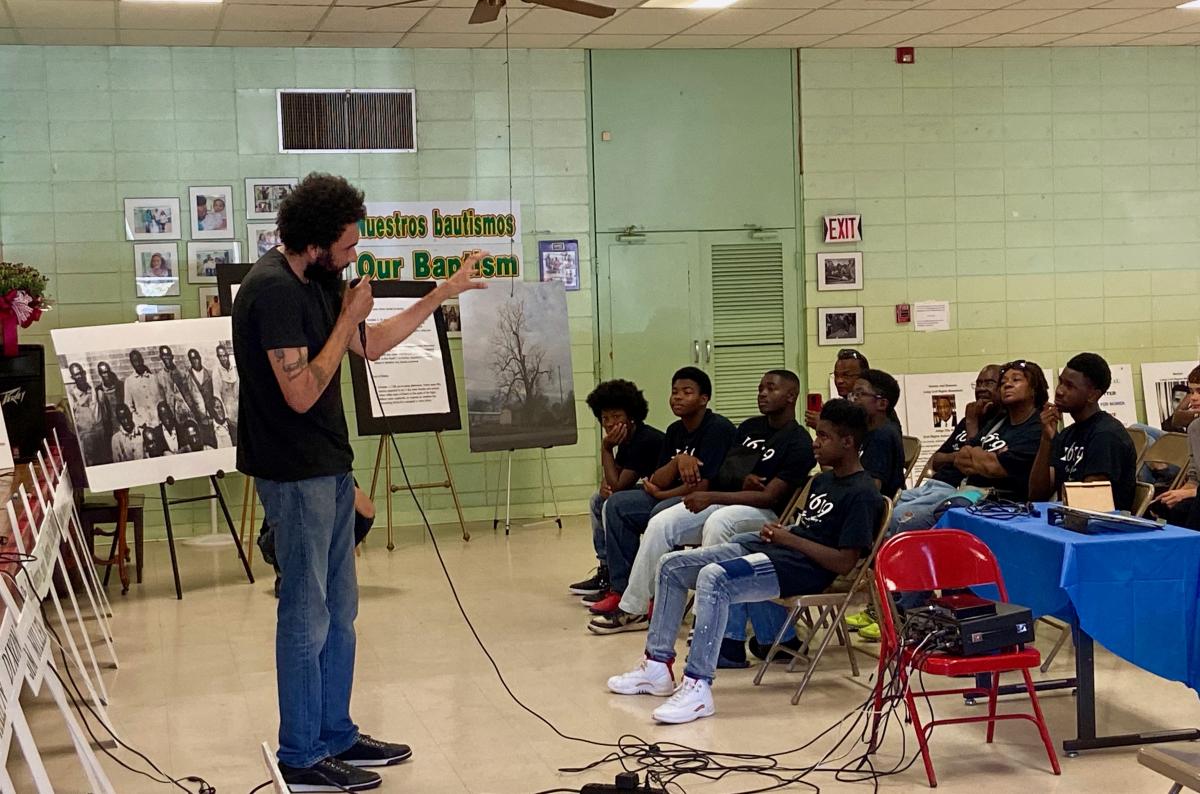
The massacre has never been part of the curriculum in Arkansas classrooms. Many people who grew up in Phillips County, black and white, say they were never taught about it by their teachers or family. Even many of those whose ancestors were directly involved, including Miller the judge and Johnson the poet, became conscious about its horrors only as adults. So historians, including Mitchell, have put together an online exhibit and curriculum guide to make the history accessible for students and teachers alike.
In Elaine, crowds of school children were at nearly every commemorative event. Speakers addressed them directly, reminding them of their proud history and that the place they are from is "the motherland of civil rights" in the words of Olson, the Legacy Center's president.
There's a clear sense among the adults here that the children need to learn this history — of landownership and unionizing and fighting back against exploitative racial and economic forces — so that they too feel empowered to break out of the cycle of poverty and operate the engines of economic success that have been driving white wealth in the Delta for generations.
Jonathan Jackson, son of civil rights leader Rev. Jesse Jackson, was the featured speaker at the Sept. 30 Healing of the Land event in Elaine. He spoke directly to approximately 20 children from Elaine and the surrounding area who had been brought to the event by their school. He encouraged them to think beyond Elaine, to work towards science degrees at the state's flagship universities, and to come back to work for the cotton industry they grew up around — not as sharecroppers but as scientists shaping agriculture's future. "I want you to know that your mind can transcend this area," Jackson said. "I want you to break the shackles."
After the ceremony, the students wrote their names on tulip bulbs that will be planted in the newly christened Richard Wright Park, which honors the author who lived in Elaine as a child with his family until his uncle, who owned a successful saloon, was murdered by a white man. Wright's work has been credited with helping to transform U.S. race relations in the mid-20th century; the park and the tulips will serve as a reminder to local children of the black success that this land has supported.
Yet the push for black self-determination and success in Phillips County is accompanied by the overwhelming sense that there's still a need for restitution and reparation. The litany recited at the Legacy Center's church service emphasizes the debt many still feel they are owed by state and county elites.
"For 100 years, they have not attempted to make an accounting about the lives that were slain, the land, farm implements, livestock, and household belongings that were stolen and seized," it read. "Have mercy upon us, O Lord."
Tags
Olivia Paschal
Olivia Paschal is the archives editor with Facing South and a Ph.D candidate in history at the University of Virginia. She was a staff reporter with Facing South for two years and spearheaded Poultry and Pandemic, Facing South's year-long investigation into conditions for Southern poultry workers during the COVID-19 pandemic. She also led the Institute's project to digitize the Southern Exposure archive.
